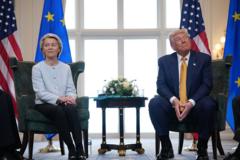Following the announcement of a trade agreement between the European Union (EU) and the United States, the initial relief felt by European leaders is now overshadowed by a growing sense of dissatisfaction. The deal, which was heralded as a breakthrough to avoid the imposition of a 30% tariff initially proposed by former President Donald Trump, has left numerous unresolved issues that could have significant ramifications for EU countries.
While a 15% tariff on most EU exports is a notable improvement, many leaders are expressing disappointment with the terms negotiated by European Commission President Ursula von der Leyen. Although there was a consensus that the agreement offered a degree of certainty amid an unpredictable trade environment, criticism is mounting over the perceived lack of a more aggressive negotiating position.
Germany's finance minister, Lars Klingbeil, acknowledged the significance of reaching an agreement but articulated that he had hoped for a more favorable outcome. “Still, all in all, it is good that there is an agreement with the US, that there are no further escalations,” he remarked.
The overarching sentiment is that while this agreement represents a first step, it does not fully address the needs and nuances of all EU member states. The European Commission has emphasized that the agreement will not constitute a legally binding contract but rather a “set of political commitments.” This ambiguity raises concerns regarding various sectors potentially facing challenges as negotiations unfold.
Different interpretations have emerged surrounding the agreement, especially regarding tariffs on critical sectors such as pharmaceuticals and semiconductors. The White House maintains that these categories will incur a 15% tariff; however, the EU contends they will remain at 0% until a consensus on global tariff regulations can be reached. Similar discrepancies exist regarding defense investments, with the US claiming a commitment for significant purchases while the EU provides a far less definitive outlook.
Particularly hit by these tariffs will be countries like Germany, Ireland, and Italy, which are heavily reliant on exports to the US. For German automotive companies, which account for a significant portion of their exports, the increased levy poses a substantial financial burden. Irish exports, notably in pharmaceuticals, also depend considerably on the US market, prompting a mixed response among Irish officials who see this deal as a necessary compromise rather than a comprehensive solution.
Italian leaders echo similar sentiments, with concerns that the new tariffs may cost the nation dearly, possibly impacting GDP growth. The potential for monetary restitution from the EU is already being discussed, but some analysts warn that this could inadvertently favor US tariffs by placing the financial burden on taxpayers.
As negotiations proceed, the pressure on the European Commission to secure more favorable terms for member states grows, particularly in light of the criticism they have faced since the announcement. While the deal has provided some measure of predictability, the path ahead remains fraught with challenges that require careful negotiation and consideration from European leaders.
While a 15% tariff on most EU exports is a notable improvement, many leaders are expressing disappointment with the terms negotiated by European Commission President Ursula von der Leyen. Although there was a consensus that the agreement offered a degree of certainty amid an unpredictable trade environment, criticism is mounting over the perceived lack of a more aggressive negotiating position.
Germany's finance minister, Lars Klingbeil, acknowledged the significance of reaching an agreement but articulated that he had hoped for a more favorable outcome. “Still, all in all, it is good that there is an agreement with the US, that there are no further escalations,” he remarked.
The overarching sentiment is that while this agreement represents a first step, it does not fully address the needs and nuances of all EU member states. The European Commission has emphasized that the agreement will not constitute a legally binding contract but rather a “set of political commitments.” This ambiguity raises concerns regarding various sectors potentially facing challenges as negotiations unfold.
Different interpretations have emerged surrounding the agreement, especially regarding tariffs on critical sectors such as pharmaceuticals and semiconductors. The White House maintains that these categories will incur a 15% tariff; however, the EU contends they will remain at 0% until a consensus on global tariff regulations can be reached. Similar discrepancies exist regarding defense investments, with the US claiming a commitment for significant purchases while the EU provides a far less definitive outlook.
Particularly hit by these tariffs will be countries like Germany, Ireland, and Italy, which are heavily reliant on exports to the US. For German automotive companies, which account for a significant portion of their exports, the increased levy poses a substantial financial burden. Irish exports, notably in pharmaceuticals, also depend considerably on the US market, prompting a mixed response among Irish officials who see this deal as a necessary compromise rather than a comprehensive solution.
Italian leaders echo similar sentiments, with concerns that the new tariffs may cost the nation dearly, possibly impacting GDP growth. The potential for monetary restitution from the EU is already being discussed, but some analysts warn that this could inadvertently favor US tariffs by placing the financial burden on taxpayers.
As negotiations proceed, the pressure on the European Commission to secure more favorable terms for member states grows, particularly in light of the criticism they have faced since the announcement. While the deal has provided some measure of predictability, the path ahead remains fraught with challenges that require careful negotiation and consideration from European leaders.




















